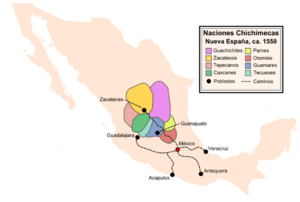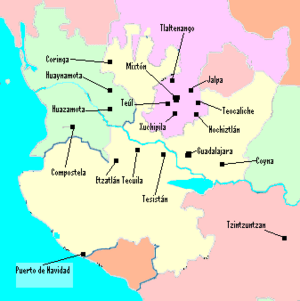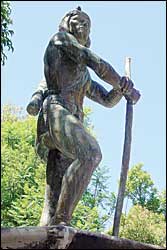Francisco Tenamaztle facts for kids
Francisco Tenamaztle (who lived in the 1540s and 1550s) was an important leader of the Caxcan people in Mexico. He led his people during the Mixtón War from 1540 to 1542. Later, he was put on trial in Spain. With help from Bartolomé de las Casas, he argued for his people's rights. He asked King Carlos I to understand their side of the story.
Early Life and Spanish Arrival
The Caxcan people lived in northwestern Mexico. They first met the Spanish in 1529. This was when Nuño Beltrán de Guzmán led an expedition. He traveled from Mexico City with hundreds of Spanish soldiers. He also had thousands of Aztec and Tlaxcaltec allies. They marched through areas that are now states like Jalisco and Zacatecas.
For six years, Guzmán often raided villages. He captured and enslaved thousands of native people. Guzmán and his officers started new towns and Spanish settlements. This region was called Nueva Galicia. One of the first temporary sites for Guadalajara was in Tenamaztle’s home area of Nochistlán, Zacatecas. The Spanish tried to force native people to work for them. This system was called `encomienda`. The native people resisted more as the Spanish moved further from Central Mexico.
Tenamaztle became a Catholic sometime after Guzmán's trip. He was given the Christian name Francisco. He became the "Lord Tlatoani of Nochistlan." This was a main town and region in southern Zacatecas. The Caxcan Indians were often called part of the Chichimeca. This was a general name the Spanish used for native groups in northern Mexico. However, the Caxcanes were settled farmers. They lived in permanent towns and villages. They were likely the most northern farming people in inland Mexico.
Tenamaztle likely promised loyalty to the Spanish king when he was baptized. He was also confirmed in his leadership role. But Spanish rule was very harsh. In mid-1540, the Caxcanes and their allies revolted. These allies included the Zacatecos and possibly other Chichimeca tribes. We do not know exactly how the Caxcanes were organized. But Tenamaztle became their most important leader.
The Mixtón War Begins
The Mixtón War started after 18 native leaders were arrested. Nine of them were hanged in mid-1540. Later that year, native people killed a Spanish `encomendero` (a person in charge of an `encomienda`). Spanish officials also found out that native people were doing "devilish" dances. After two Catholic priests were killed, many native people left the `encomiendas`. They hid in the mountains. Many went to the strong hill fortress of Mixtón.
The acting governor, Cristóbal de Oñate, led a Spanish and native force. He wanted to stop the rebellion. The Caxcanes killed a group of people sent to make peace. This group included one priest and ten Spanish soldiers. Oñate tried to attack Mixtón, but the native people on the hill fought back. They stopped his attack. Oñate then asked for more soldiers from Mexico City.
The Viceroy Antonio de Mendoza asked Pedro de Alvarado for help. Alvarado was an experienced Spanish conqueror. Alvarado decided not to wait for more soldiers. He attacked Mixton in June 1541. He had four hundred Spanish soldiers and many native allies. He met a native army there. The Spanish estimated it had 15,000 fighters. This army was led by Tenamaztle and Don Diego, a Zacateco leader.
The first Spanish attack failed. Ten Spanish soldiers and many native allies were killed. Alvarado's later attacks also did not work. On June 24, a horse fell on him, hurting him badly. He died on July 4.
The native people felt stronger after this. Tenamaztle led an attack on Guadalajara in September. But they were pushed back. The native army went back to Nochistlan and other strong places. The Spanish leaders were very worried. They feared the revolt would spread. They gathered a large force. It had 450 Spanish soldiers and 30,000 to 60,000 Aztec, Tlaxcalan, and other native allies. Viceroy Mendoza then invaded the Caxcanes' land.
With his huge army, Mendoza captured the native strongholds one by one. On November 9, 1541, he captured the city of Nochistlan. He also captured Tenamaztle. But the native leader later escaped. In early 1542, the Mixton stronghold fell to the Spanish. The rebellion was over. After the Caxcanes were defeated, many were taken away. Thousands were forced to work in mines. Many survivors, mostly women and children, were moved from their homes. They were made to work on Spanish farms. The Viceroy ordered men, women, and children to be captured and executed. Reports of this extreme violence against native people led to an investigation. The Council of the Indies secretly looked into the Viceroy's actions.
After the defeat, Tenamaztle, another leader named Guaxicar, and their followers hid in the mountains of Nayarit. They stayed hidden for nine years. This area was mainly lived in by the Cora people. The Spanish did not fully control it until 1722. It was the last place native people resisted Spanish rule in Nueva Galicia. In 1551, Tenamaztle willingly gave himself up to the Bishop of Nueva Galicia. The Bishop took him to Mexico City. After an investigation, Spanish officials confirmed his identity. They knew he was the leader of the Caxcanes in the Mixton War. On November 17, 1552, he was ordered to be sent to Spain for trial.
Trial in Spain
In Spain, Tenamaztle was first put in prison in Valladolid. Later, he lived in a Dominican monastery. There, he met Bartolomé de las Casas. Las Casas helped him present his case. Justice moved slowly. It was July 1, 1555, before Tenamaztle could speak to the King. He also spoke to the Council of the Indies.
Tenamaztle's plan was to:
- Show that he was the rightful `tlatoani` (leader) of Nochistlan.
- Prove that the Caxcan people had welcomed the Spanish peacefully. He argued he should have all the rights of a loyal subject to the King of Spain.
- Accuse Nuño de Guzmán, Cristóbal de Oñate, and Miguel de Ibarra of harming and killing native people.
- Declare that the Caxcanes' war was "natural justice." This was because of the bad treatment they received from the Spanish.
He asked the king to return his lands, wife, and children to him.
Tenamaztle asked the king to think about "the terrible wrongs and evils" the Caxcanes had suffered. He said the native people did not want to rebel. Instead, they wanted to "flee the cruel treatment they faced." The trial continued for more than a year without a decision. The last known paper about the trial is from August 7, 1556. We do not know what happened with the case after that. We also do not know what happened to Tenamaztle. He likely died in Spain.
See also
 In Spanish: Francisco Tenamaztle para niños
In Spanish: Francisco Tenamaztle para niños




